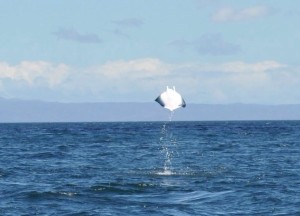
The Pacific Giant Manta
The Pacific Giant Manta is a remarkable creature. It is why many people come to dive with us in Costa Rica and visit the Catalina Islands which give you the chance to see these animals. The manta glides through the water with incredible grace and ease. They are some of the biggest animals in the ocean behind only whales and sharks. They have been confirmed to be 25 feet from wing tip to wing tip and weigh as much as 3000lbs. Despite their huge size they are still some of the least understood and studies animals in the ocean today. This has began to change due to the work of some people who are dedicating a lot of time and resources to this magnificent species. In Mozambique there is a a marine biologist, Andrea Marshall who has been dedicating her life and her studies to Manta Rays for the past decade or so. Below is an interesting video about mantas, conservation, and exploring the ocean. It is 15 minutes long but is worth the watch if you have some time.
Some interesting things that she has discovered in her studies is the habitat of Mantas. It came as quite a shock to me, as the mantas I have seen in Costa Rica are generally spotted quite close to the surface of the dive sites (in 10-40 feet of water most of the time), but manta rays travel to some very deep parts of the ocean. Up to 4500 feet deep. They also discovered that there are different species of mantas. The mantas that we have in Costa Rica are amongst the Mantas which travel great distances in migratory patterns. Other species which are found in other areas stay relatively close to their home reefs.
Manta rays recently were listed as a protected species in international waters greatly due to the efforts of people like Andrea Marshall. Studying these animals allowed marine biologists to recognize that the gestational period of a manta ray is very long and that they generally only have one offspring per delivery. Baby manta rays are actually housed in a small egg type pouch inside of their mothers uterus throughout the gestational period. When they hatch they actually remain inside the mother for a period and drink uterine milk called hisotrophe until they are ready to emerge. When they emerge from the uterus they are already between 5 and 7 feet in width. While information is still fairly limited it is suggested that mantas likely only have one pregnancy every 5 to 7 years which makes them quite susceptible to human threats such as over fishing as it takes a long time for the populations to recover.
There is now an effort to catalogue individuals from this species based upon their unique black spots which are present on the underside of mantas. Researchers are still attempting to find out more information about the longevity of mantas, where they travel, how long they stay, and if they return to the same locations. If you have gotten any great pictures of mantas while diving in Costa Rica we would love to be able to share them with our other customers.







